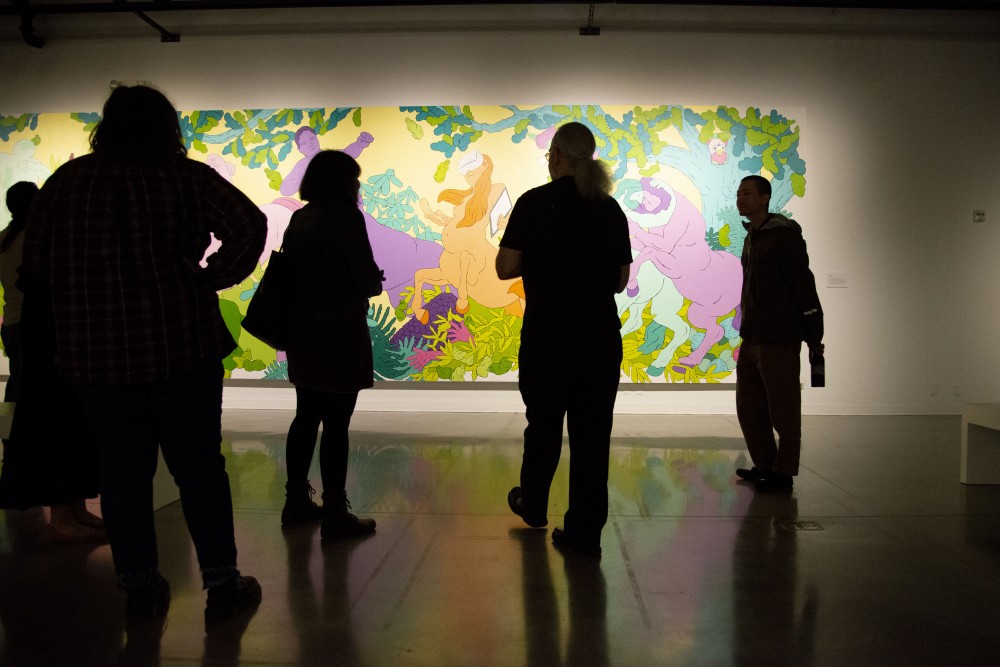In recognition of the 50th anniversary of the Stonewall uprising and the first gay liberation organization at the University of Minnesota, the Katherine E. Nash gallery presents “Queer Forms.”
The multidisciplinary art exhibition features 100 artists celebrating queer identity. However, they’re also highlighting queer survival and the politics and culture surrounding the community.
“People conceive of different notions — in this case, the notion of liberation — in a variety of ways and they express it in a variety of ways,” said Howard Oransky, the director and curator of the Nash gallery.
Oransky began organizing what would become “Queer Forms” in 2013, looking for artists and other resources who would agree to make this vision come to life.
Through his colleagues, he found that 2019 marked the anniversary of three events important to queer liberation in the United States: the Stonewall uprising of 1969, the Cooper Do-nuts riot of 1959 and the formation of a University of Minnesota student group called F.R.E.E. in 1969, which stood for “Fight Repression of Erotic Expression.”
“I wanted there to be this kind of a historical narrative,” Oransky said. “It’s suggesting that this is a phenomenon that crosses all these boundaries of time: past, present and future.”
The visual art in “Queer Forms” is placed strategically and often allows older and newer artworks to share the same space. In one part of the exhibition, eight Valentine’s Day cards created by contemporary artist Savana Ogburn are placed around a 1963 photograph of drag queen Marlow La Fantastique.
“It’s very overwhelming and beautiful and powerful to see that many queer voices in one space,” said Kevin Martin, a University alum who has art displayed in the exhibition.
One of the pieces commissioned for the exhibition, created by Alex Petersen, stands 10 feet tall and 32 feet wide. Petersen, a University alum, drew inspiration from the 1635 painting “Love of the Centaurs” by Peter Paul Rubens to create a brightly colored vision of LGBTQ+ liberation and celebration.
In Rubens’ painting, a male centaur and a female centaur are embracing in the woods. Petersen’s centaurs — both men — embrace among other centaurs of different genders, prancing about in a lush and lively forest.
“I wanted to re-appropriate that historical context and bring it into a contemporary moment,” Petersen said. “I also really wanted to push it into the future.”
“Queer Forms” isn’t just a chronology of the LGBTQ+ liberation movement — it’s a story about how the past, present and future of the movement can coexist in a space.
“While the exhibition is beautiful and moving and safe, a lot of the stories that are in there are difficult and heavy and about barely making it,” said Corinne Teed, an assistant professor of art at the University and visual artist whose work is displayed in the exhibition.
In addition to the visual art hung on the walls, the staff behind “Queer Forms” has organized special events in accordance with the exhibit. Until the exhibit closes in December, the lineup includes theatrical performances, drag and burlesque shows and recently, a fashion show.
Just as LGBTQ+ folx come from many backgrounds and experiences, art comes in many forms.
“I wanted it to feel experimental, open-ended, and in a way, to not conform to any standard narrative of progress,” Oransky said. “Or [conform to] the usual kind of discourse that would suggest that tomorrow is going to be even better. But rather, here’s a whole galaxy of expression.”
What: Theatrical Performance: seven.years.of.shed.skin…
When: Oct. 14, 7 p.m.
Where: InFlux Space at the Regis Center for Art, 405 21st Ave. S., Minneapolis
Cost: Free, but register in advance for seating








